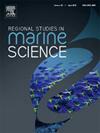Prediction of potential fishing grounds for chub mackerel in the Northwest Pacific utilizing a combination of multivariable Gaussian mixture model and Bayesian approach
IF 2.1
4区 环境科学与生态学
Q3 ECOLOGY
引用次数: 0
Abstract
Chub mackerel is an economically important pelagic fish species in the Northwest Pacific Ocean. Accurate forecasting of fishing grounds can greatly improve the fishery production capacity and support conservation-focused fisheries management. This study utilized China's fishery catch data for chub mackerel in the Northwest Pacific from 2014 to 2019, along with various marine environmental factors, including sea surface temperature (SST), chlorophyll concentration (CHL), eddy kinetic energy (EKE), sea surface height anomaly (SSHA), and the strength of the SST gradient (SSTG), to develop a predictive model for fishing grounds. Initially, two Gaussian mixture distributions were simulated to ascertain the distributions of environmental factors for "true" and "false" fishing grounds, respectively. Subsequently, a fishing ground prediction model was constructed using a Bayesian approach informed by the parameters of the Gaussian mixture models. Additionally, a novel training dataset division scheme was established based on cross-validation results to enhance the model's training and testing accuracy, as well as its generalization capability. The forecasting model was ultimately validated against actual fishery data collected from April to November 2020, revealing that the predicted fishing ground locations closely aligned with the actual observed locations for each month. The area under the curve (AUC) values ranged from 0.667 to 0.870, with an average AUC of 0.766 and a variance of 0.076, indicating a reasonable level of accuracy in the model's forecasts. The findings of this study contribute to a deeper understanding of the influence of oceanographic conditions on chub mackerel and offer a novel approach for predicting its fishing grounds.
求助全文
约1分钟内获得全文
求助全文
来源期刊

Regional Studies in Marine Science
Agricultural and Biological Sciences-Ecology, Evolution, Behavior and Systematics
CiteScore
3.90
自引率
4.80%
发文量
336
审稿时长
69 days
期刊介绍:
REGIONAL STUDIES IN MARINE SCIENCE will publish scientifically sound papers on regional aspects of maritime and marine resources in estuaries, coastal zones, continental shelf, the seas and oceans.
 求助内容:
求助内容: 应助结果提醒方式:
应助结果提醒方式:


